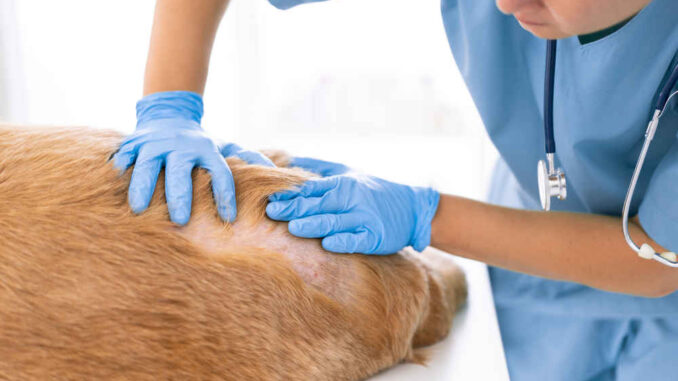
This article was updated on February 6th, 2024

Complicated does not even start to describe a dog’s skin. It does many important jobs and can show up with many often-confusing conditions and problems. In this article, we will review pictures selected by our veterinarian Dr. Chyrle Bonk & board-certified dermatologist Dr. Ian Spiegel.
We have 3 simple ways for you to look at these pictures. First, you can scroll through a picture gallery below. Second, you can view pictures by the symptoms your dog has (like red skin or scabs). Third, you can view pictures grouped by skin condition (like allergies or infections):
1. Picture gallery of common skin conditions in dogs
2. View pictures by symptoms
Click on the tiles below to view our pictures and veterinary guides categorized by symptoms:
3. View pictures by skin condition
In this section, you will find pictures categorized by type of skin problem for 22 common dog skin problems.
Dog Skin Problems Category 1: Allergies, Parasites, and Internal Conditions
1. Hot spots
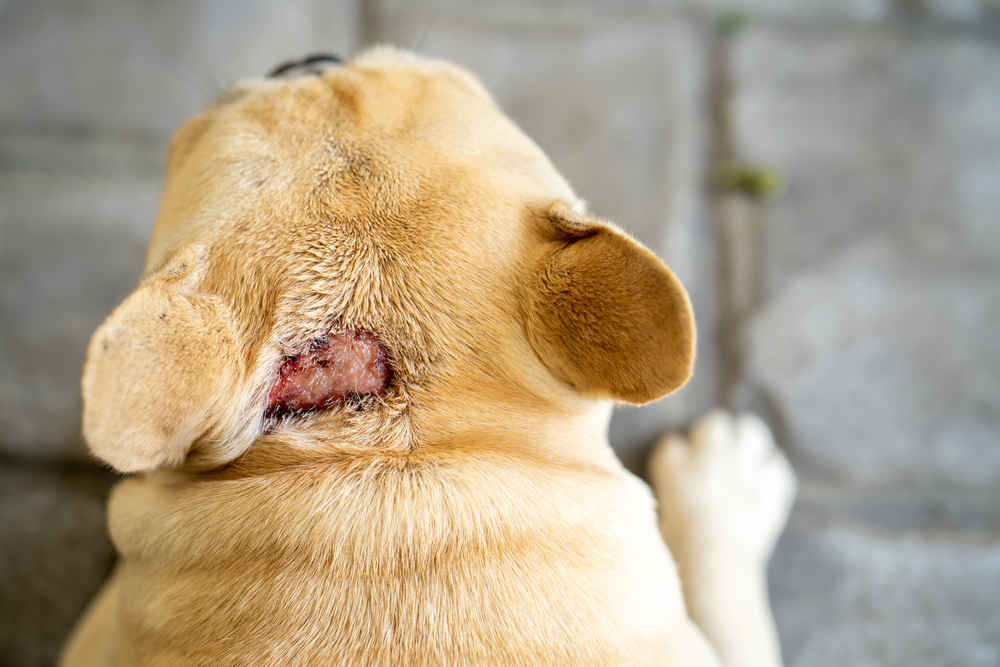
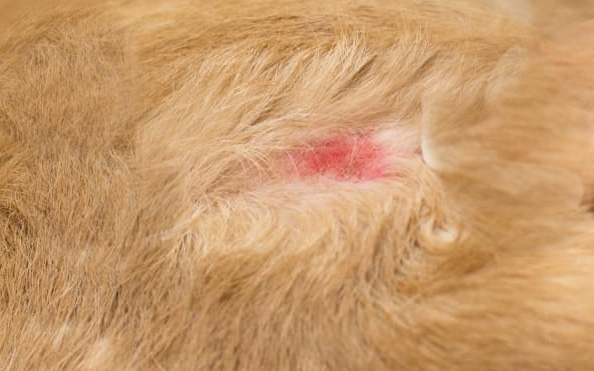
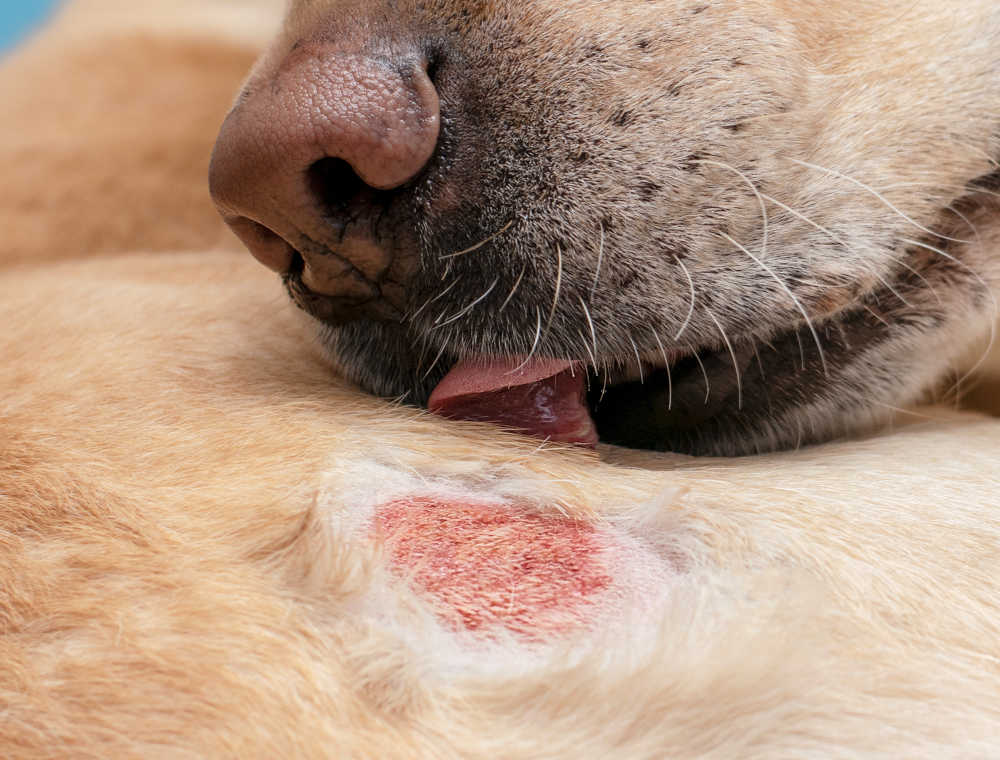
Hot spots (technically known as acute moist dermatitis or pyotraumatic dermatitis) are red, inflamed areas that can seem to appear overnight. The skin is macerated, red, irritated, and moist with purulent (pus) oozing on the surface. These spots may occur anywhere on a dog but are most common behind/under the ear, neck, cheek, legs, and hips. Often there is matted hair covering and hiding the hot spot. Though not life-threatening, these lesions can make dogs miserable.
Learn more about Hot Spots (Pictures, Diagnosis, Treatments).
2. Environmental allergies
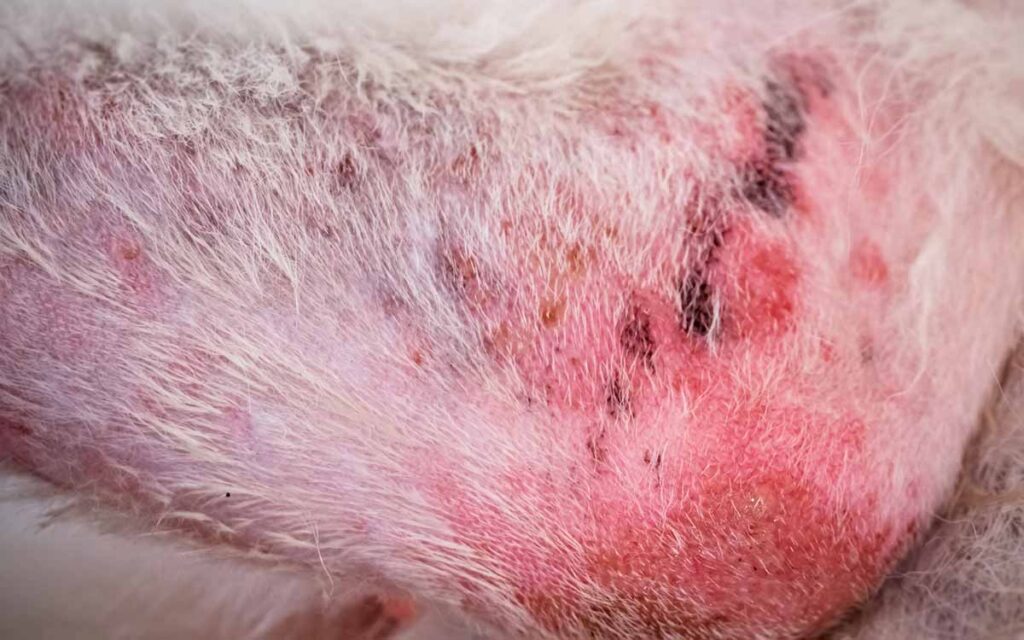
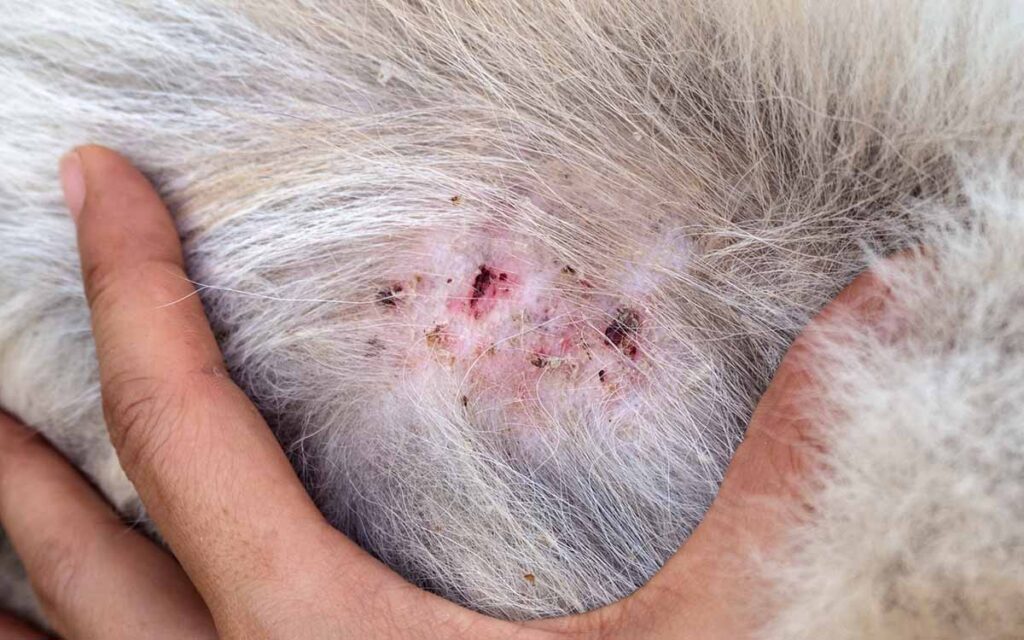
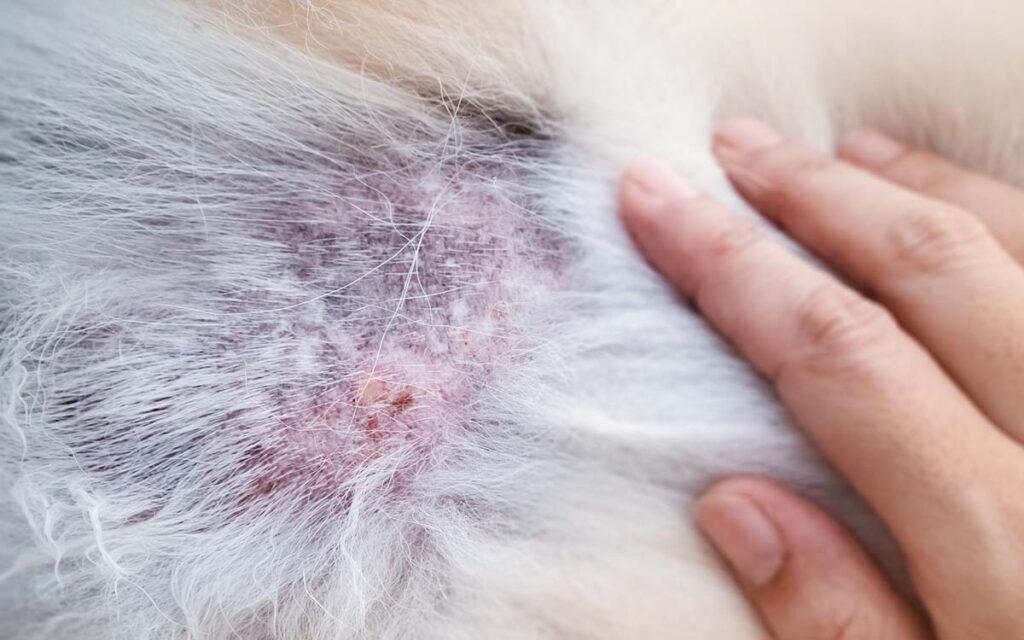
Allergies to substances in the environment can manifest as skin lesions in dogs. A dog’s immune system can become dysregulated and overreacts to allergens. This overreaction produces inflammation in the form of itchiness, redness, and heat. Excessive rubbing and irritation can lead to hair loss and the breakdown of the skin barrier which allows bacteria to overpopulate and cause secondary infections, resulting in further damage to the skin barrier.
Learn more about Environmental Allergies or Allergy Rashes.
3. Food allergy rashes (cutaneous adverse food reaction)
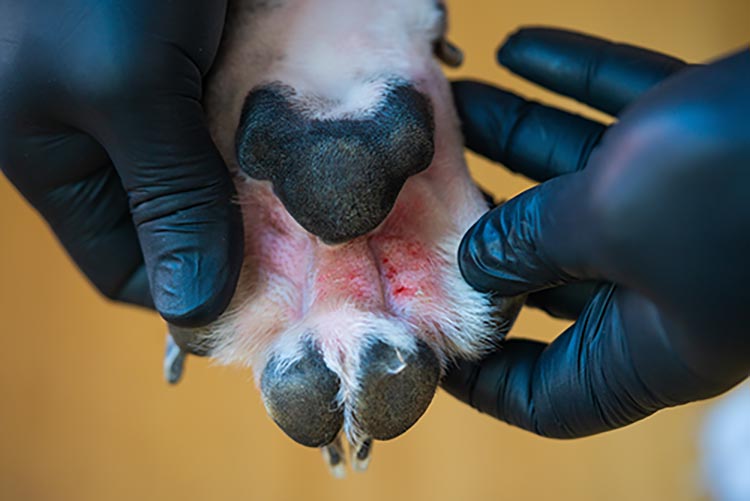
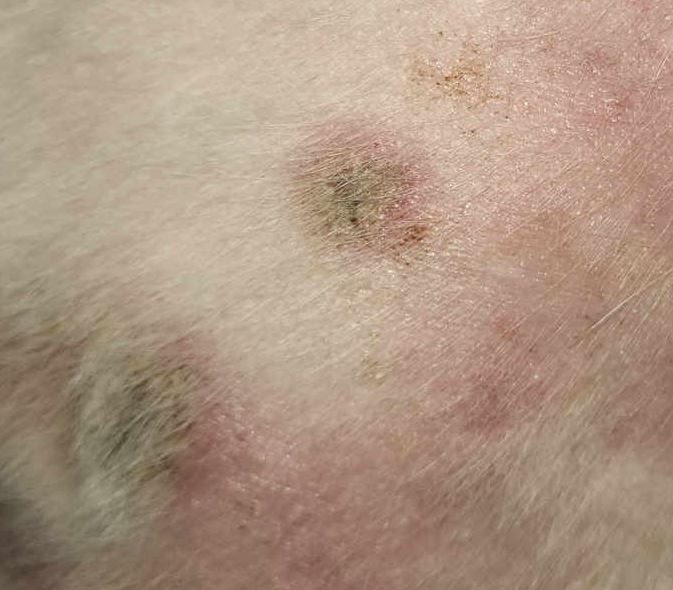
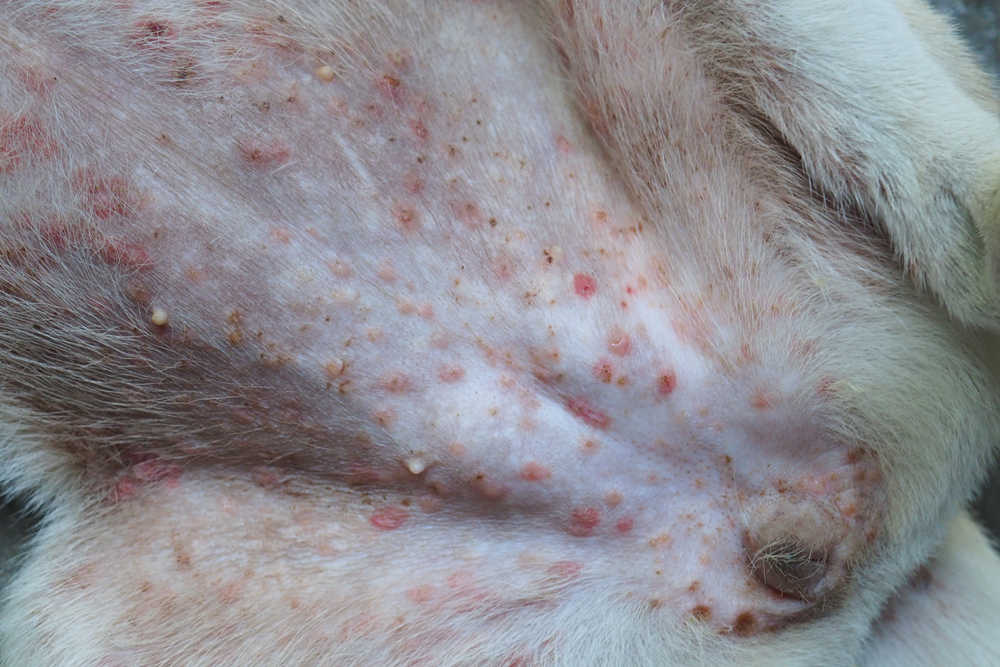
Food allergies can cause itchy paws, itchy skin, chronic ear infections, or gastrointestinal issues such as diarrhea. Another distinguishing feature is that food allergies tend to occur year-round, in contrast to environmental allergies, which are typically seasonal. To diagnose a food allergy, your veterinarian will have you feed either a limited ingredient, hydrolyzed, or a novel protein diet to your dog for at least eight weeks. This is called a food trial.
Learn more about Food Allergies in Dogs.
4. Mange (Mites / scabies)
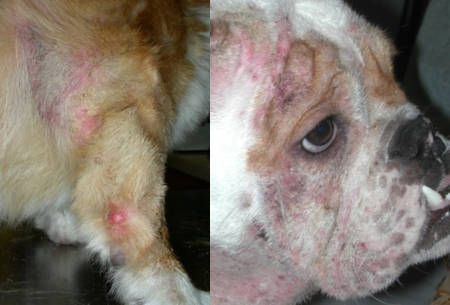
There are two main types of mange that affect dogs, demodectic and sarcoptic:
- Demodectic mange (Mites) is caused by the ‘Demodex’ mite and most commonly causes patchy hair loss in younger dogs. This condition is not itchy and not contagious.
- Sarcoptic mange (Scabies), caused by ‘Sarcoptes’ mites, is very itchy and is contagious to both other animals and humans.
Diagnosing mange in dogs involves a veterinarian scraping the hair follicles and examining the scraping under a high-power microscope to try to spot the bugs.
Learn more about Scabies and Mites.
5. Flea allergies
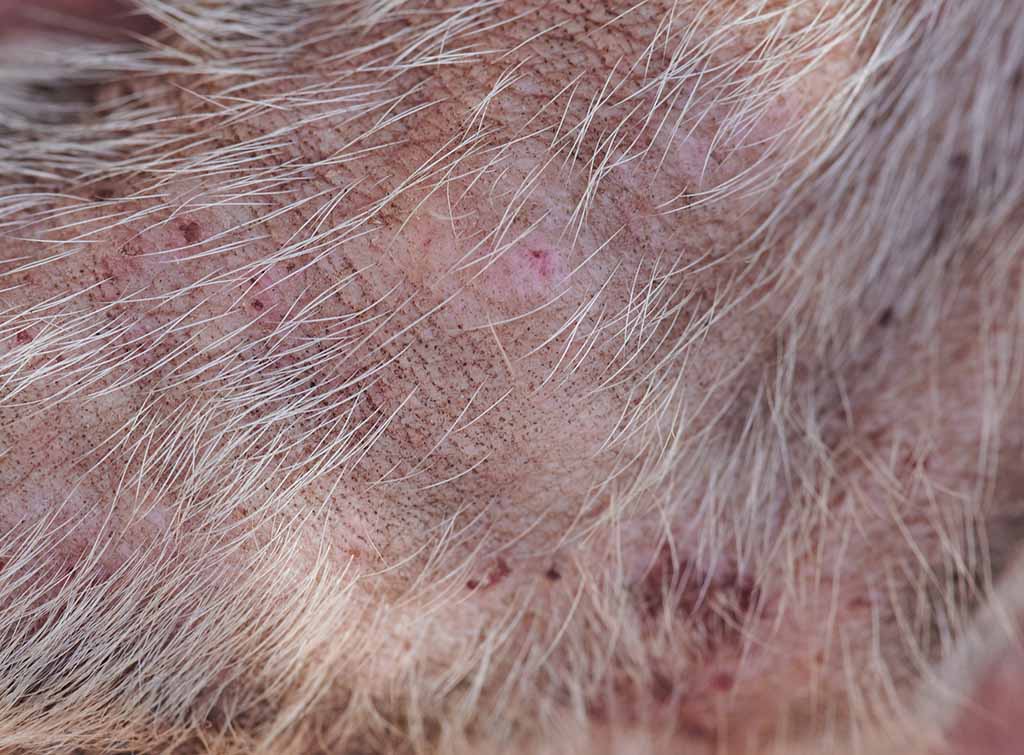
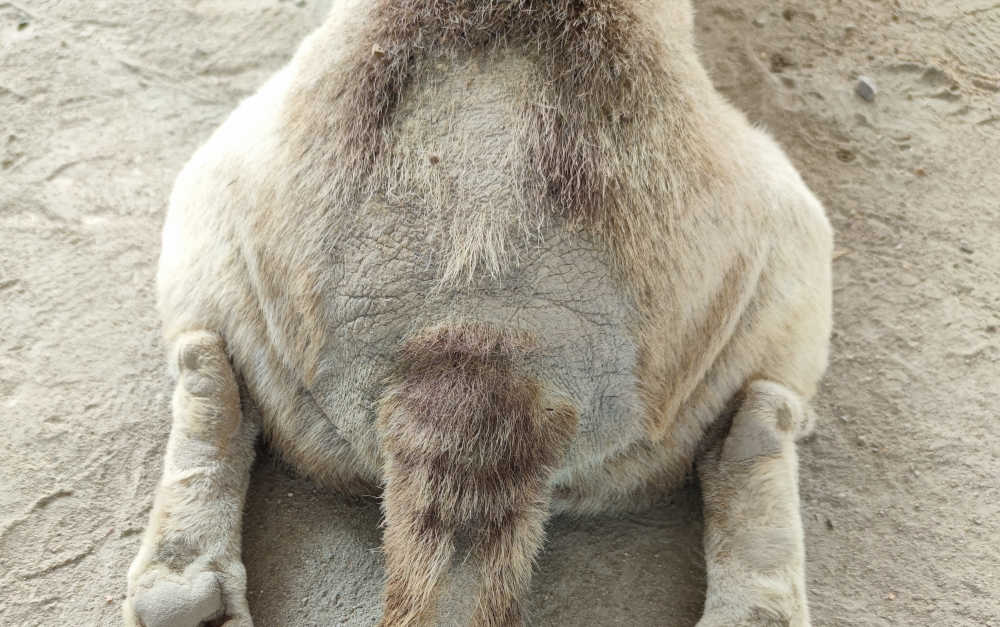
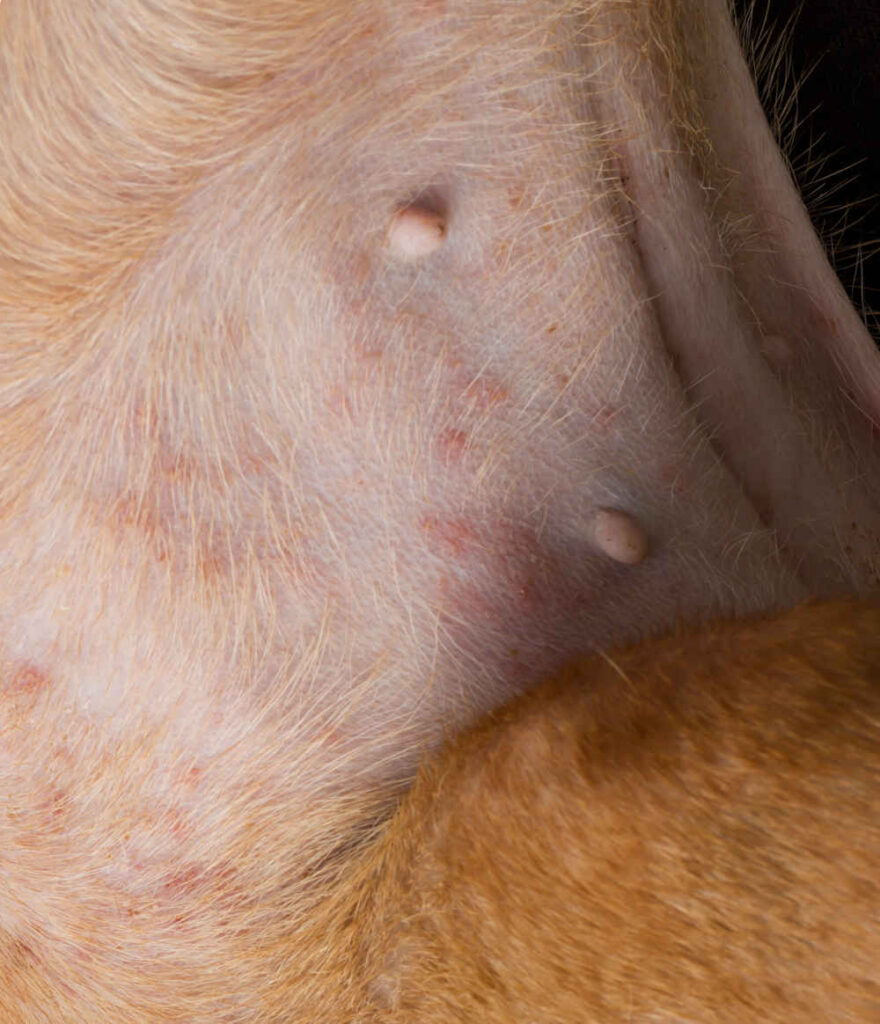
Fleas can cause all dogs to bite and scratch themselves. However, some dogs are truly allergic to fleas and may have an allergic reaction to the flea’s saliva when they bite. Flea allergy dermatitis typically presents as a red, inflamed, and scabby hind end, just above the base of the tail. Fleas may or may not be found.
Learn more: How to Tell if Your Dog Has Fleas and Flea Allergies & Flea Scabs.
6. Endocrine disease / hypothyroidism
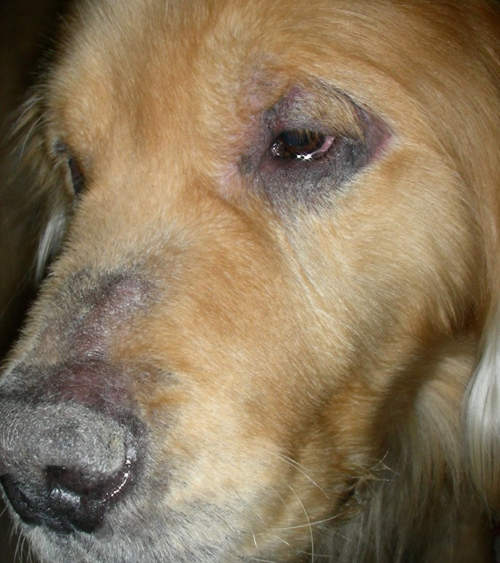
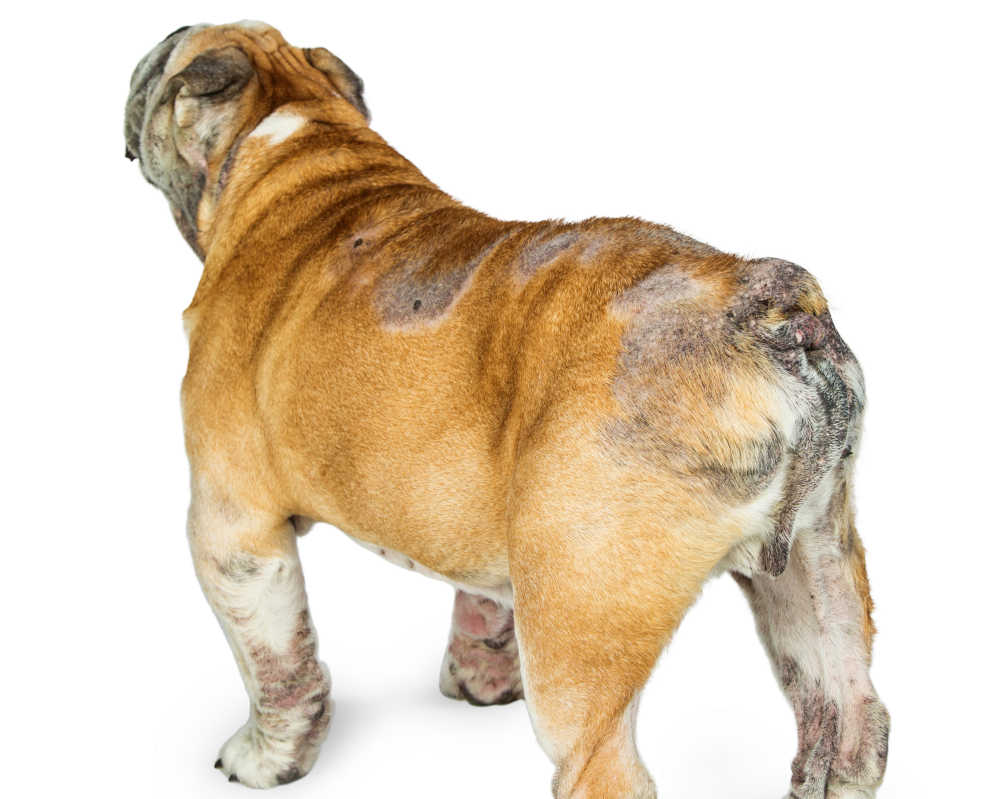
Hypothyroidism and many other endocrine diseases can result in hair loss and skin rashes in dogs. The hair loss is often in a particular symmetrical pattern across the dog’s sides that may give your veterinarian an idea of the issue. Blood tests and skin scraping will help diagnose the specific issue.
Learn more: Hypothyroidism.
7. Autoimmune disease
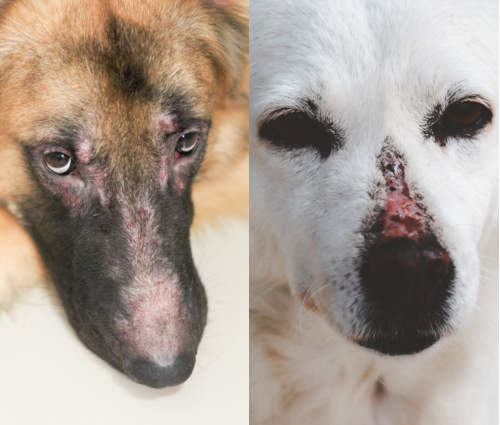
Autoimmune diseases can result in redness, inflammation, and crusting of the skin. Most commonly, the skin around the nose, mouth, and eyes is affected first. Diagnosis consists of a biopsy that will be interpreted by a veterinary pathologist.
Learn more: Autoimmune Diseases.
Dog Skin Conditions Category 2: Infections
We can categorize skin infections in dogs as bacterial or fungal. In some cases, a dog may have both!
1. Bacterial skin infections
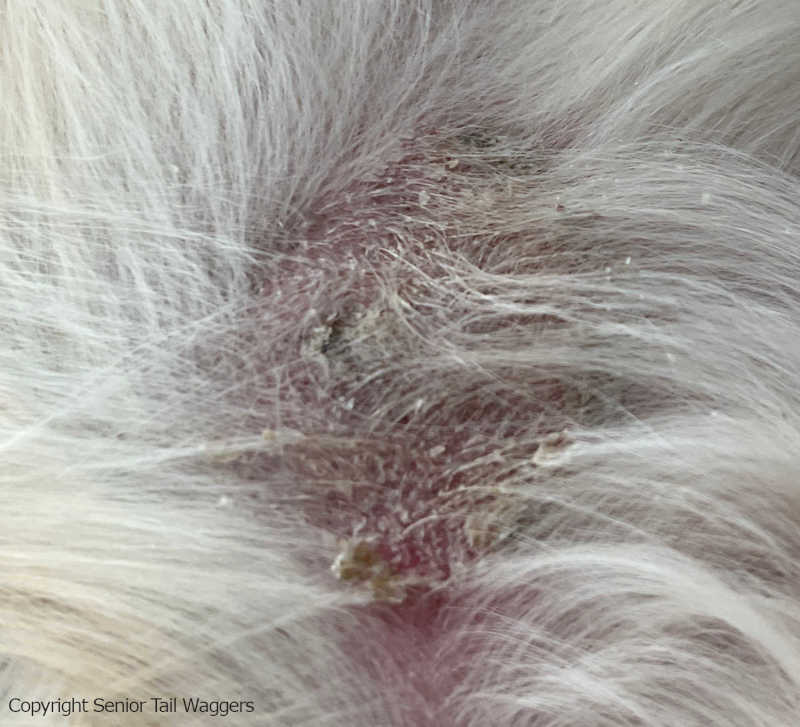
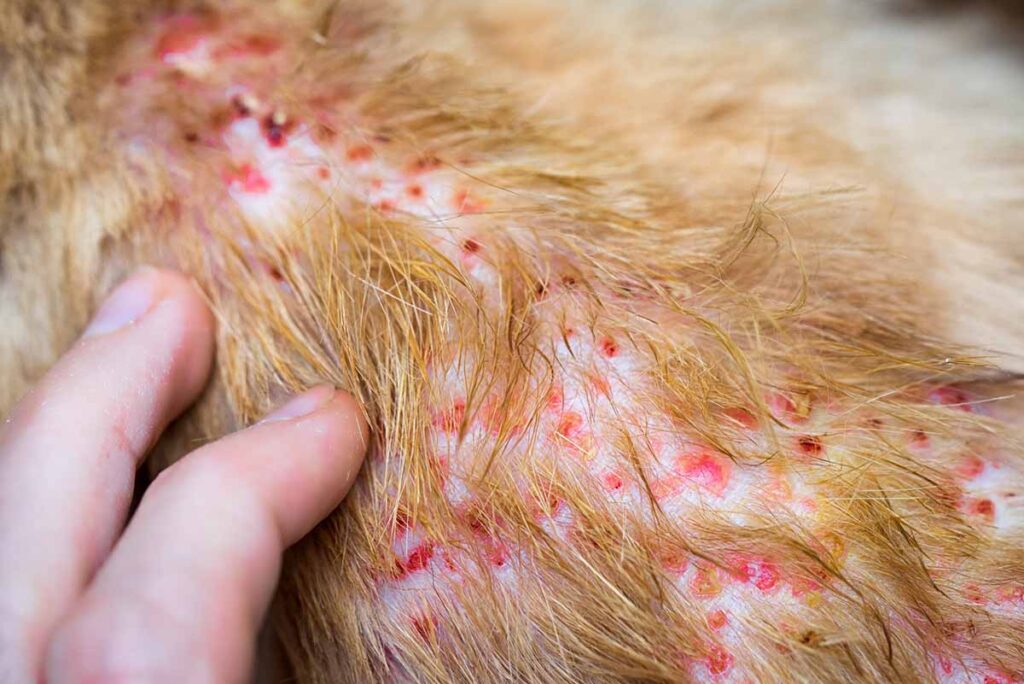
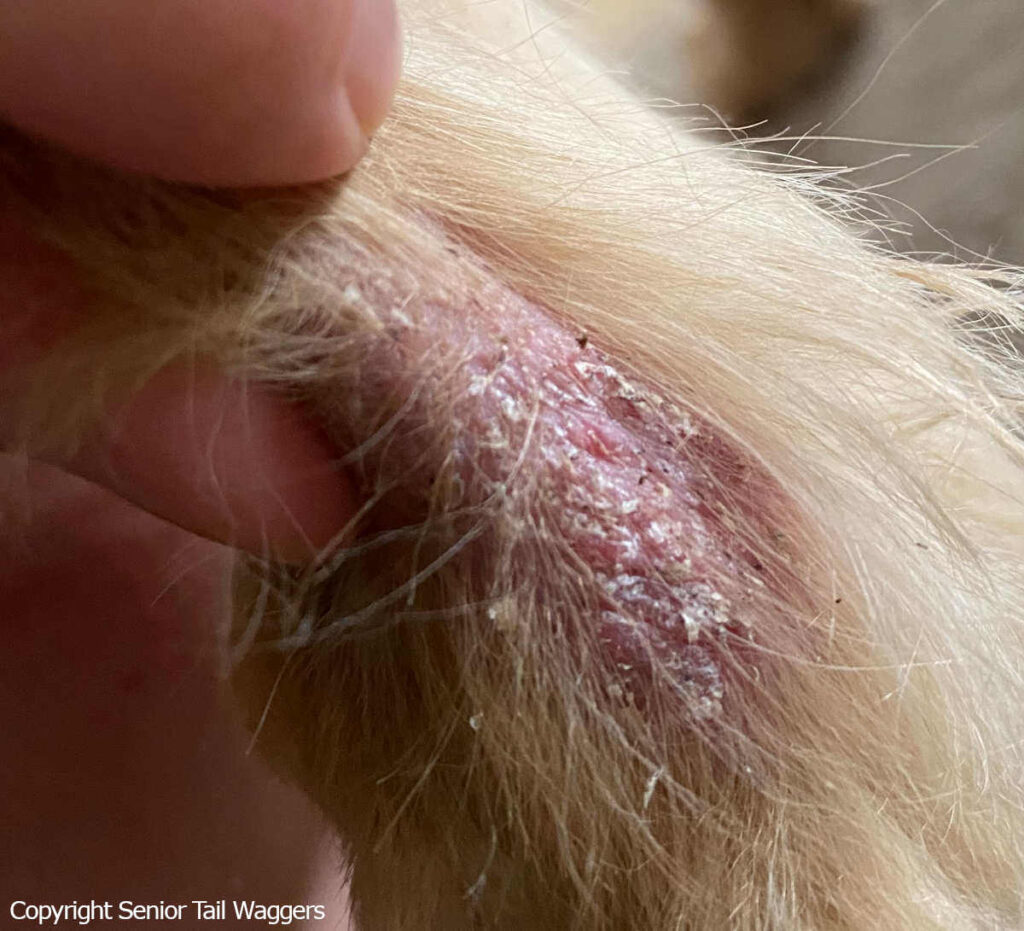
Bacterial skin infections often cause redness, pustules, and discharge. You may also notice your dog itching, chewing, or excessively licking. Infections in the skin’s most superficial or outer layers may be treated with topical antibiotic creams, ointments, or sprays. Bacteria that have penetrated into the deeper layers of the skin may need oral antibiotics to reach those tissues.
Learn more about Bacterial Skin Infections.
2. Fungal skin infections (including Ringworm)
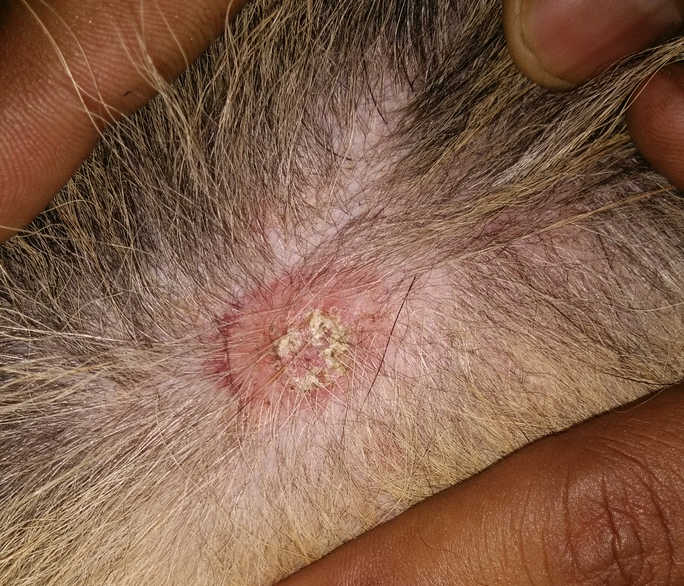
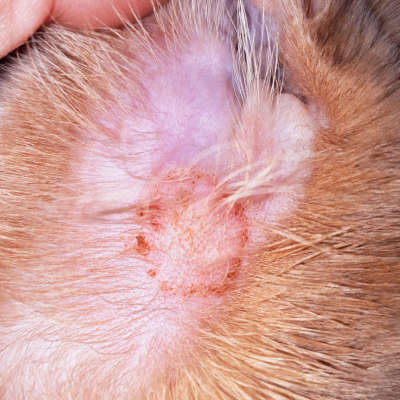
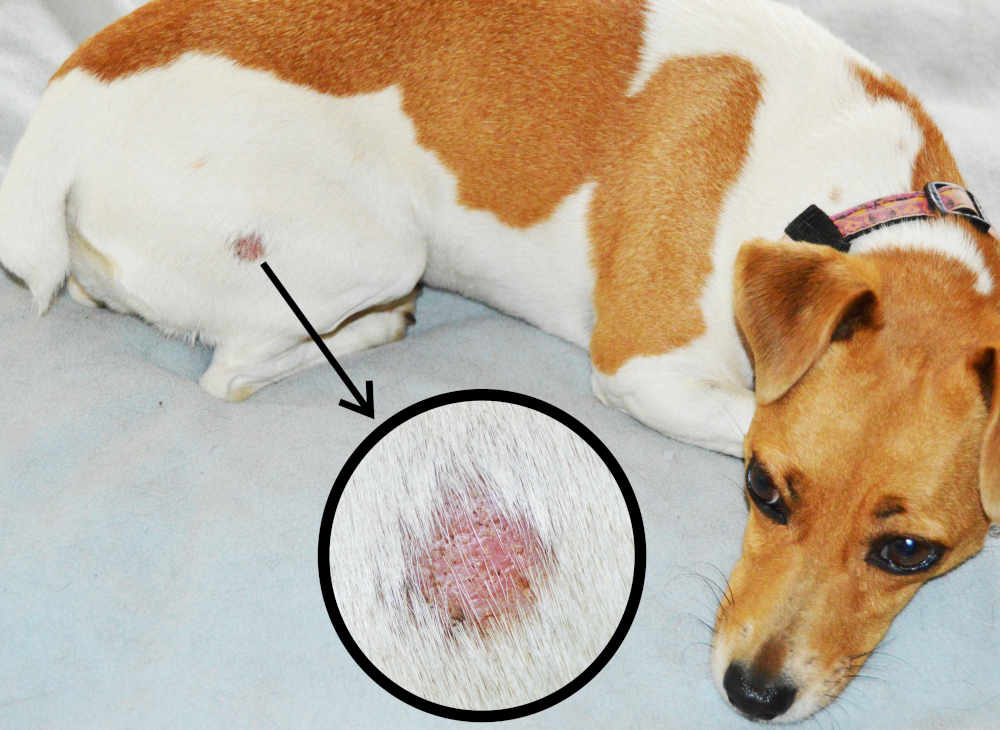
While there are multiple fungal infections, the one that strikes worry in most pet owners is ringworm, caused by Microsporum species. Despite the name, ringworm is not, in fact, a worm. Ringworm is a fungal infection that causes hair loss and scaly patches and is contagious between animals and humans. The lesions are typically circular with hair loss widening concentrically outwards. The very outer ring is often scaly. Dogs may have one lesion or up to hundreds.
Learn more about Ringworm or Fungal Skin Infections.
3. Yeast skin infections
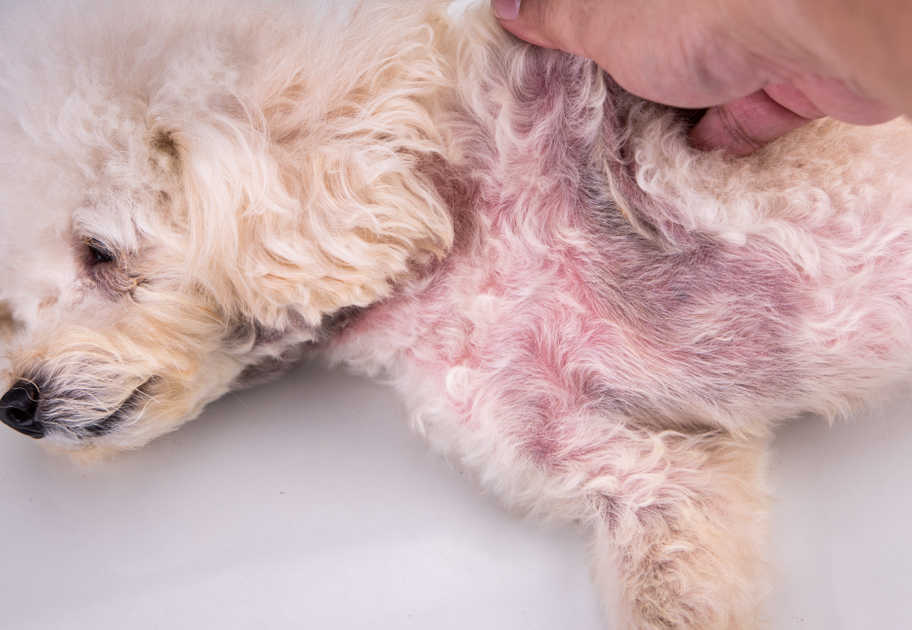
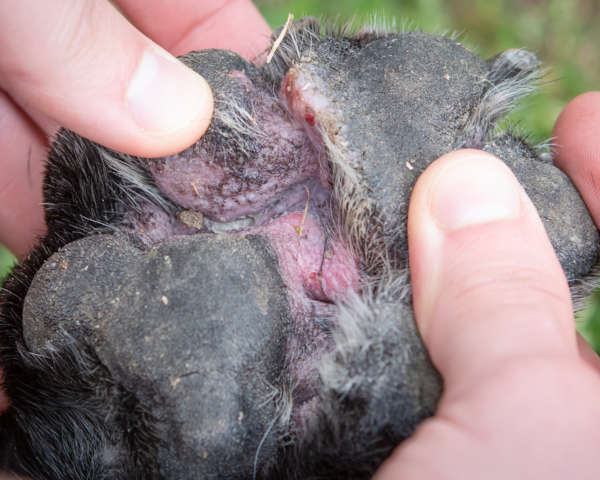
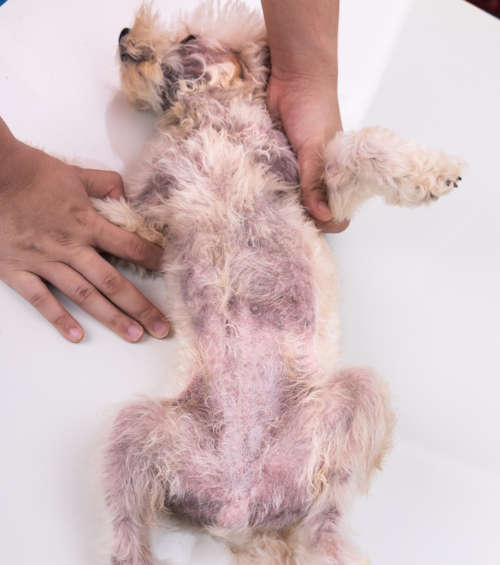
Yeast skin infections (Malassezia) are another form of fungal infection. Malassezia is one of the most frequently seen infections, especially in ears, skin folds, and paw pads. Yeast has a distinct musty or sour smell. In chronic cases, yeast infections often cause skin thickening. Depending on the severity, these infections can be treated with oral or topical medications.
Learn more about Yeast Infections.
Dog Skin Conditions Category 3: Lumps and bumps
1. Lipomas
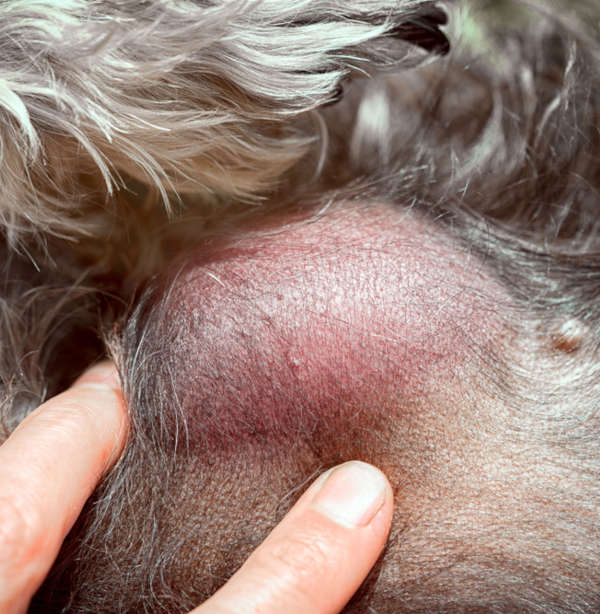
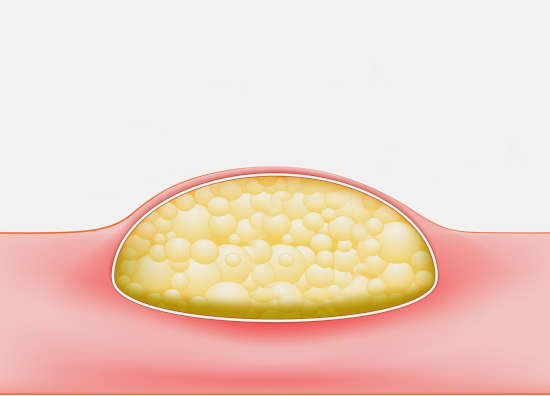
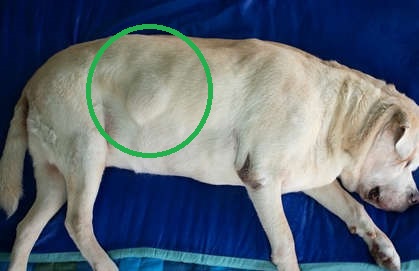
Lipomas are the most common benign (Non-cancerous) growth seen in dogs. Each lipoma is made up of a group of fat cells that forms a soft round, or oval, lump usually located just below your dog’s skin.
Lipomas are generally easy to move around and do not feel as though they are connected to deeper tissue in the body. They are usually slow growing and tend to be harmless. Sometimes they will stop growing, but don’t often disappear or get smaller. Although these common lumps are not dangerous in themselves, lipomas getting too big can cause discomfort for your dog and may need to be removed.
Learn More About Lipomas.
2. Warts
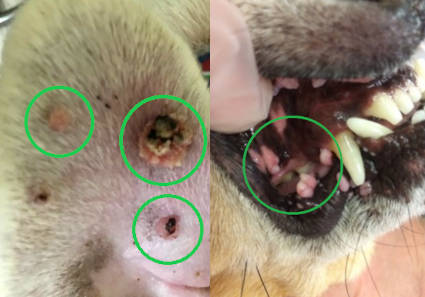
Warts (also called papillomas) are the other most common type of old dog lumps and can occur on your dog’s skin, on his eyelids, ear flaps, paw pads, between the toes, around the genital area, or in the mouth or lips. They can show up as a single small lump, or as a group or cluster of tiny lumps which look a little bit like a cauliflower floret.
Warts on dogs are most often benign and will often disappear of their own accord after a few months. Some can become irritating and cause a dog to bite or chew at them. These may be better off removed to prevent further damage to a dog’s skin.
Learn more about Warts (With Pictures & Vet Advice).
3. Sebaceous Adenomas
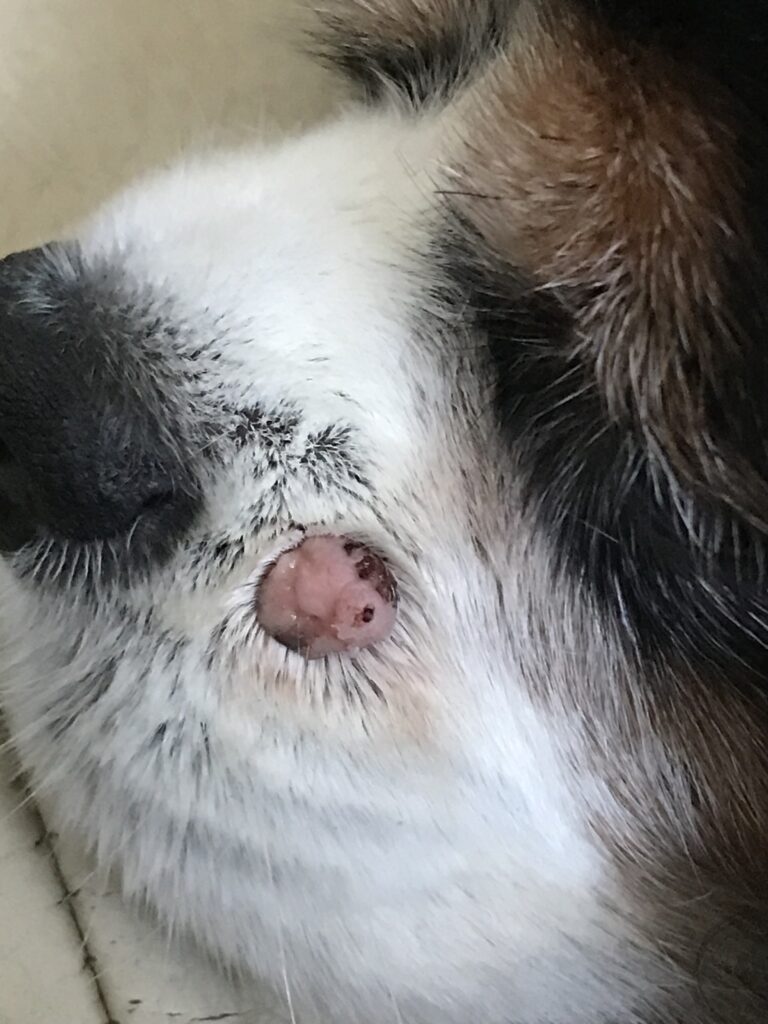
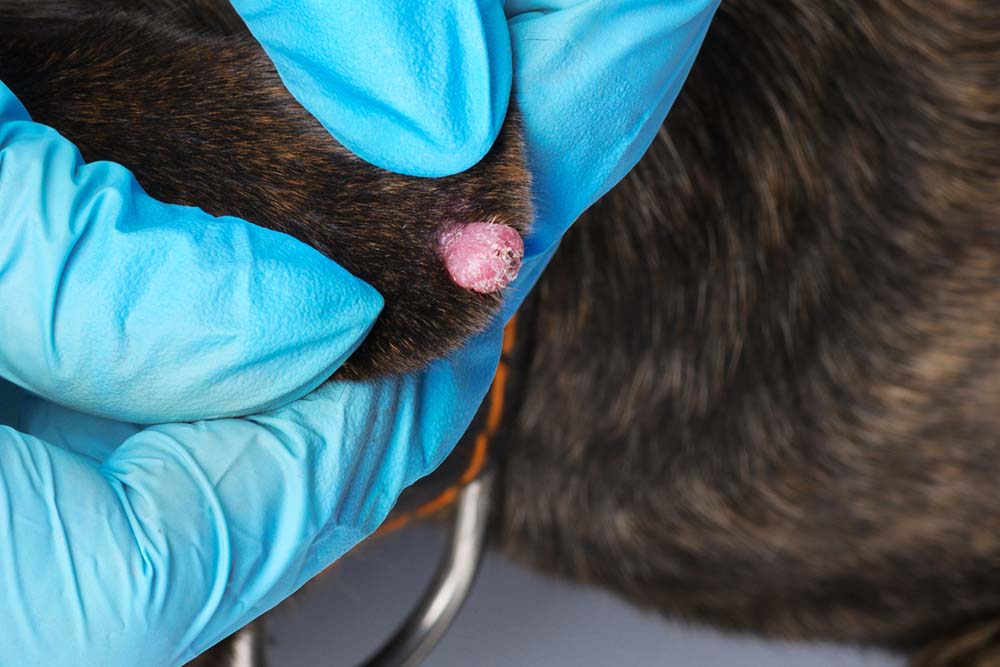
Pictured above are sebaceous adenomas. These growths tend to grow outward on to the skin surface. They are narrower at the base and are often on a thin stalk. The growths are usually 4mm to 10mm in size and sometimes they might extend below the surface. Removal is usually curative, but removal is not usually necessary unless it is getting infected or irritated (sometimes self-mutilation). The prognosis is usually good.
Learn more: Sebaceous Adenomas.
4. Follicular (Sebaceous) Cysts
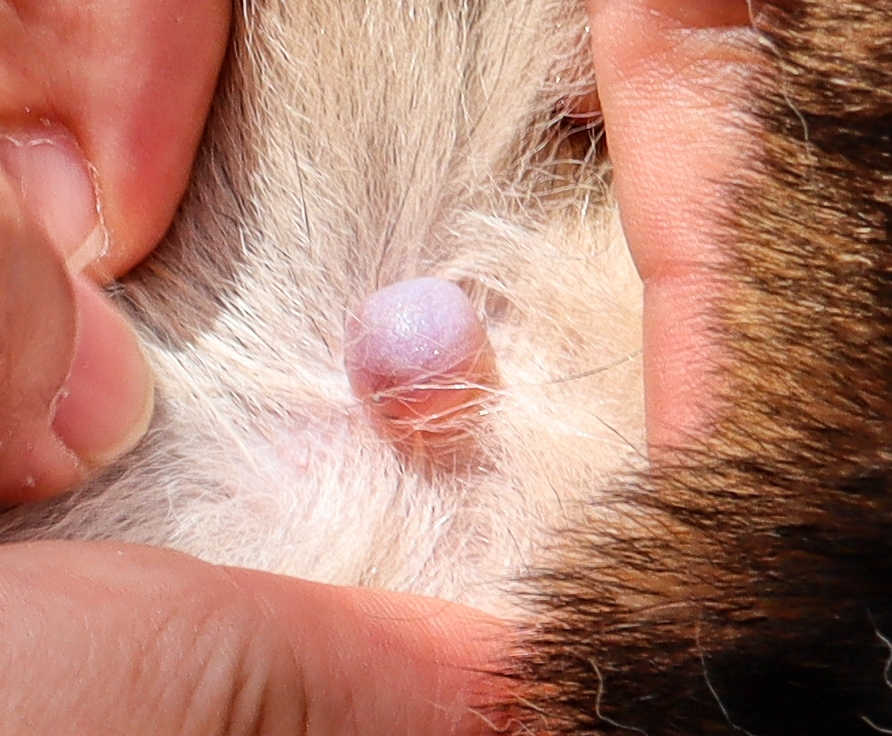
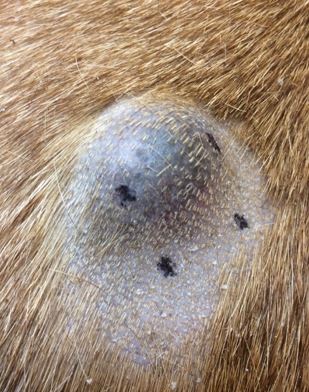
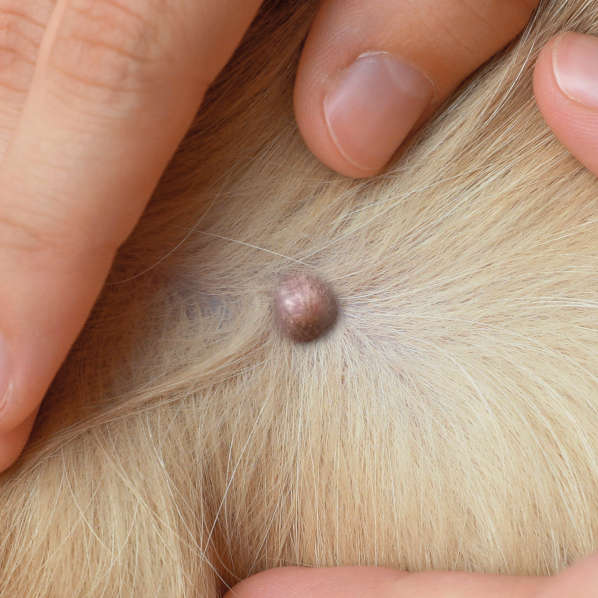
Sebaceous cysts are common in dogs of all ages and can occur singly, or your dog could have several of them. These types of cysts can be tiny or grow up to an inch or more in size, as shown on the pictures above. They tend to resemble a human ‘pimple’, just larger. Sebaceous cysts contain a thick, dark-colored liquid that may ooze out if they rupture. If sebaceous cysts are bothering your dog, your vet may advise surgically removing them.
Learn more about Sebaceous Cysts or view the different Types of Cysts.
5. Mast Cell Tumors
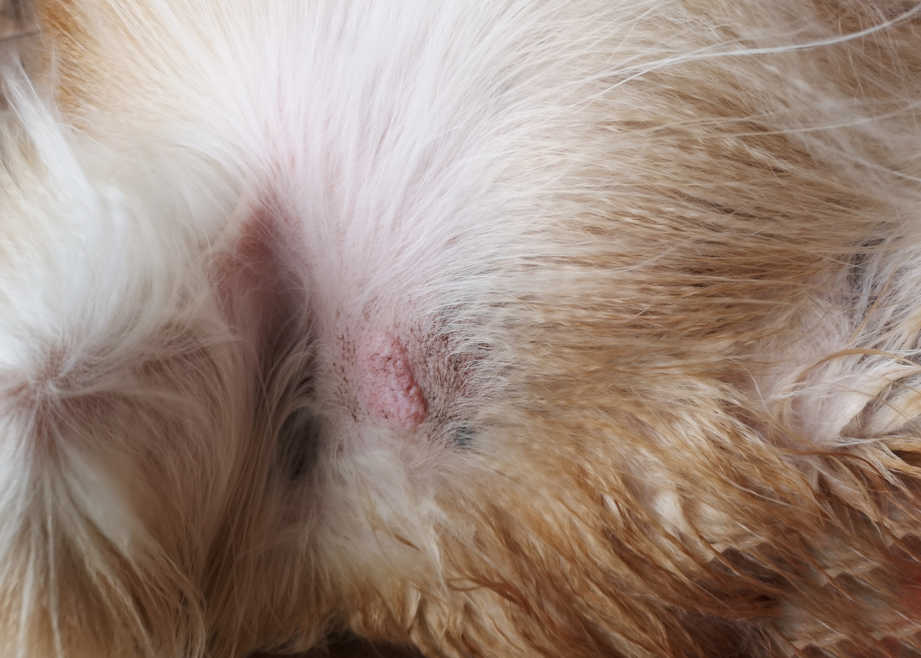
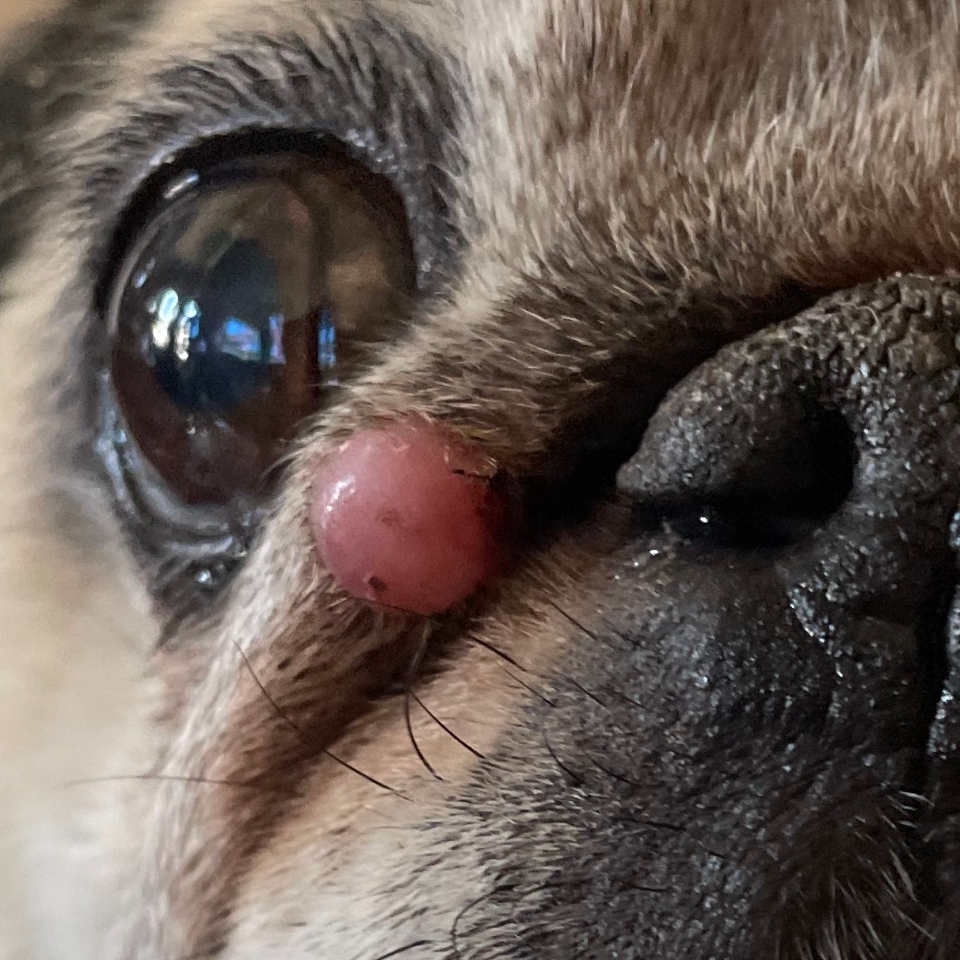
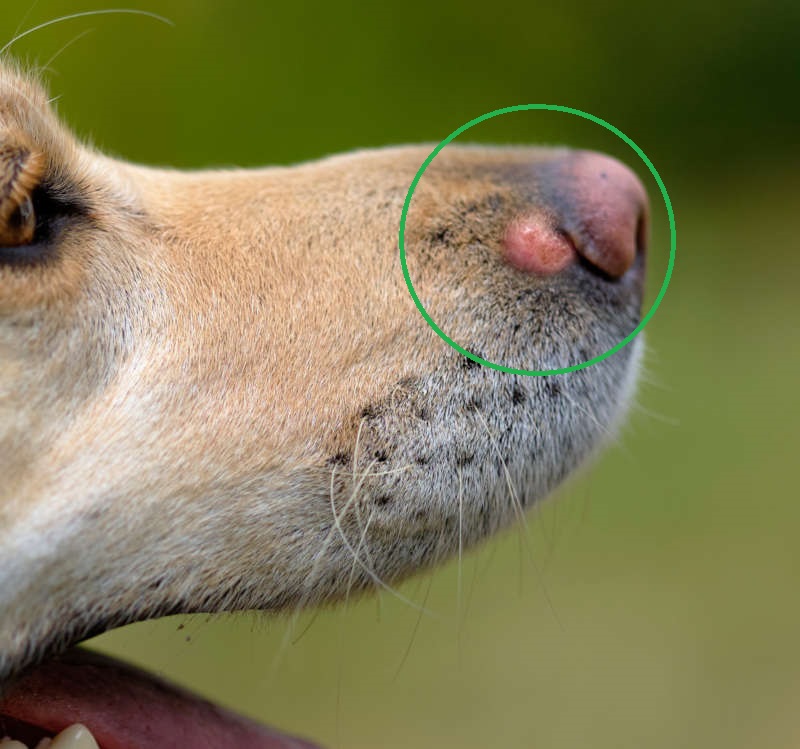
Mast cell tumors are more often seen in middle-aged and older dogs but can affect younger dogs too. These dog lumps are not always malignant, but it’s impossible to know which ones are malignant and which ones are benign without a biopsy. Single tumors that have not spread are surgically removed. Tumors that spread may require surgery and additional chemotherapy. Drugs are being developed that will specifically target and kill mast cell tumors.
Learn more about Mast Cell Tumors with pictures & vet advice.
6. Melanomas
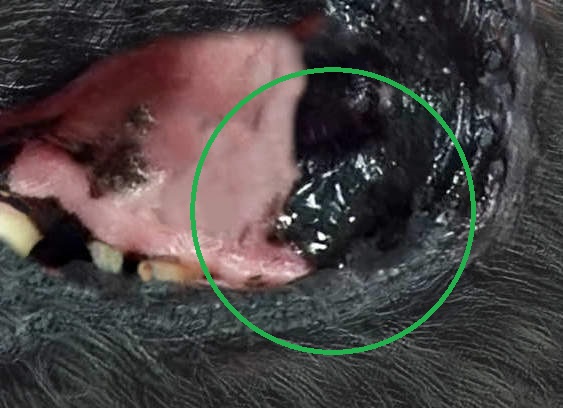
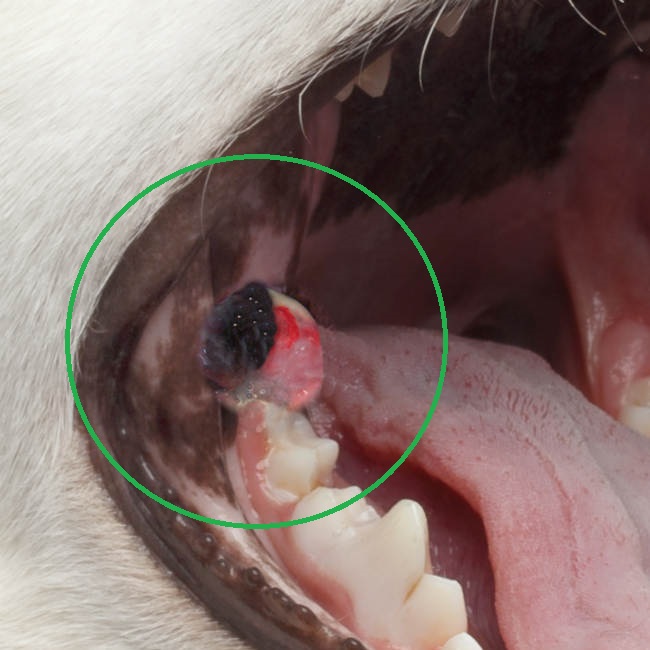
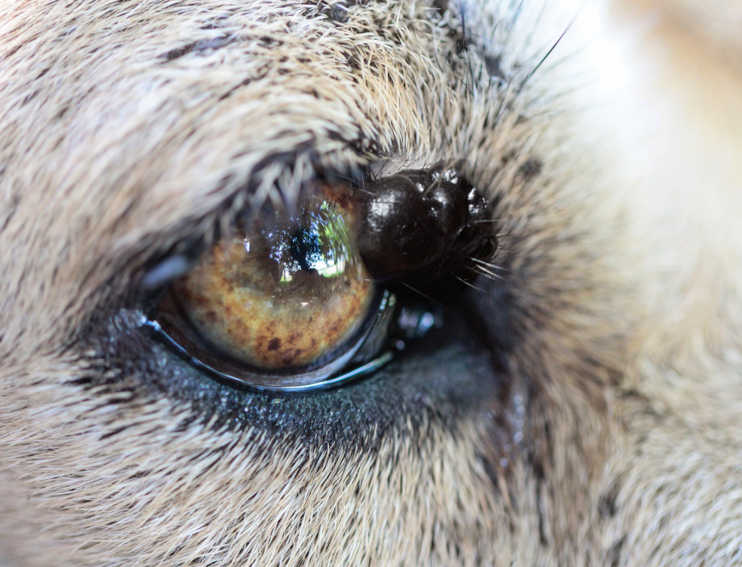
Melanoma tumors are dark and can be small, large, flat, or raised. They can appear as a solitary smooth surfaced pigmented nodule, a multilobulated nodule, or even somewhat flat. They can be either benign or malignant, so they shouldn’t be ignored. If a dog has malignant melanoma, it’s usually an aggressive cancer which spreads throughout the body quickly, so the lesion needs to be surgically removed as quickly as possible. Most malignant melanomas in dogs grow in/around the mouth or in other mucus membranes, but they can also be found in other areas.
Learn more about Melanomas.
7. Squamous Cell Carcinomas
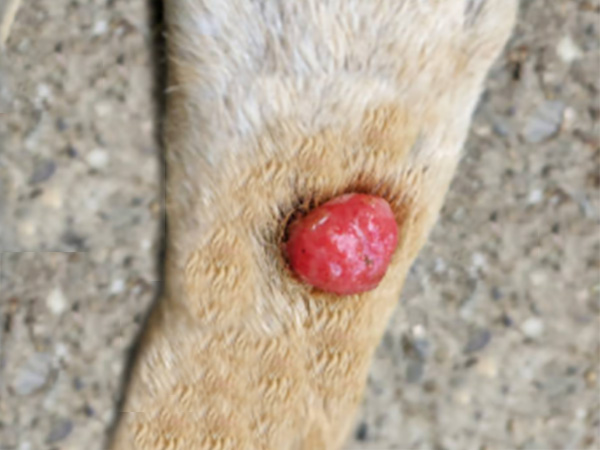
Squamous cell carcinomas in dogs are rare, and they are not as aggressive in terms of spreading—usually focally. However, like some aggressive melanomas or high grade mast cell tumors are, these can spread (metastasis). They can also occur on the skin and nail beds.
They are not as aggressive in terms of spreading as melanoma or mast cell tumors are. These types of malignant tumors are usually found on areas of skin that are bare, or have little hair, and are more common in dogs with light-colored skin. Squamous cell tumors in dogs can be raised lumps or nodules, or flatter areas of ulcerated skin. They can sometimes resemble adenomas as well as warts.
8. Hemangiosarcoma / Hemangioma Tumors
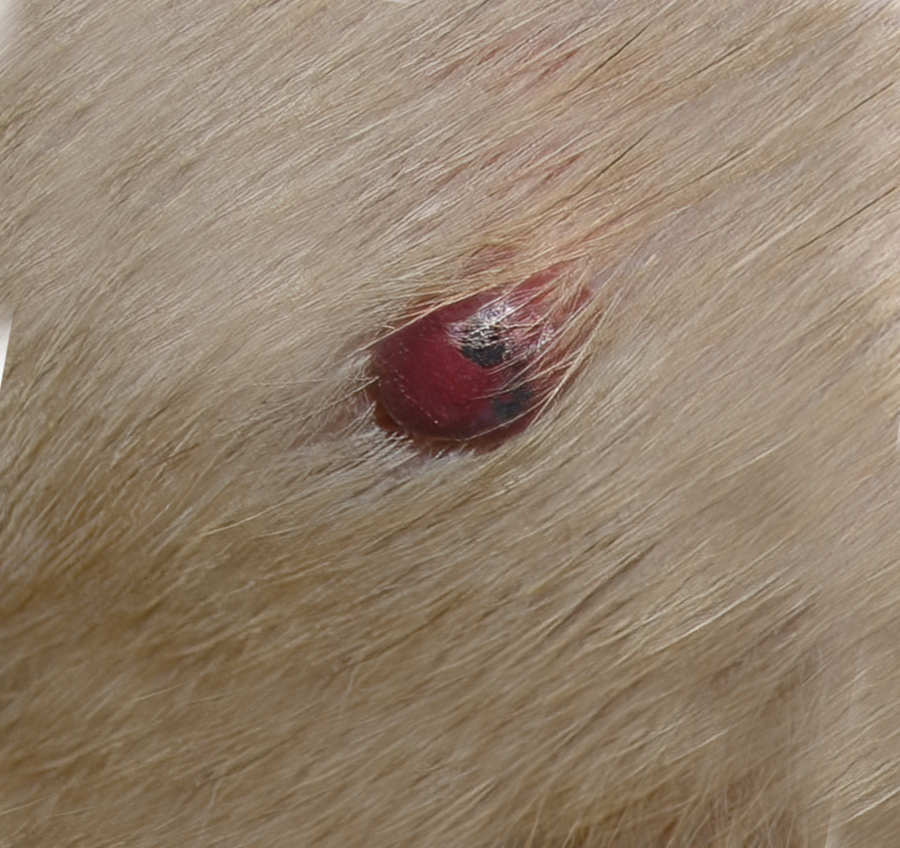
Hemangiosarcoma is a malignant cancer of the cells that line the blood vessels of the body. Therefore, hemangiosarcoma can occur anywhere in the body where blood vessels are found. In the case of hemangiosarcoma, the cells that line the blood vessels start dividing uncontrollably and in an unhealthy manner.
This leads to the development of a mass that is very prone to rupture and can even cause a dog to bleed out internally. Luckily, what is usually found on the skin are benign blood vessel tumors known as melanocytomas. These are benign blood vessel growth. They may even be in part induced by extended periods of solar exposure.
Read more about Hemangiosarcoma.
9. Mammary gland tumors
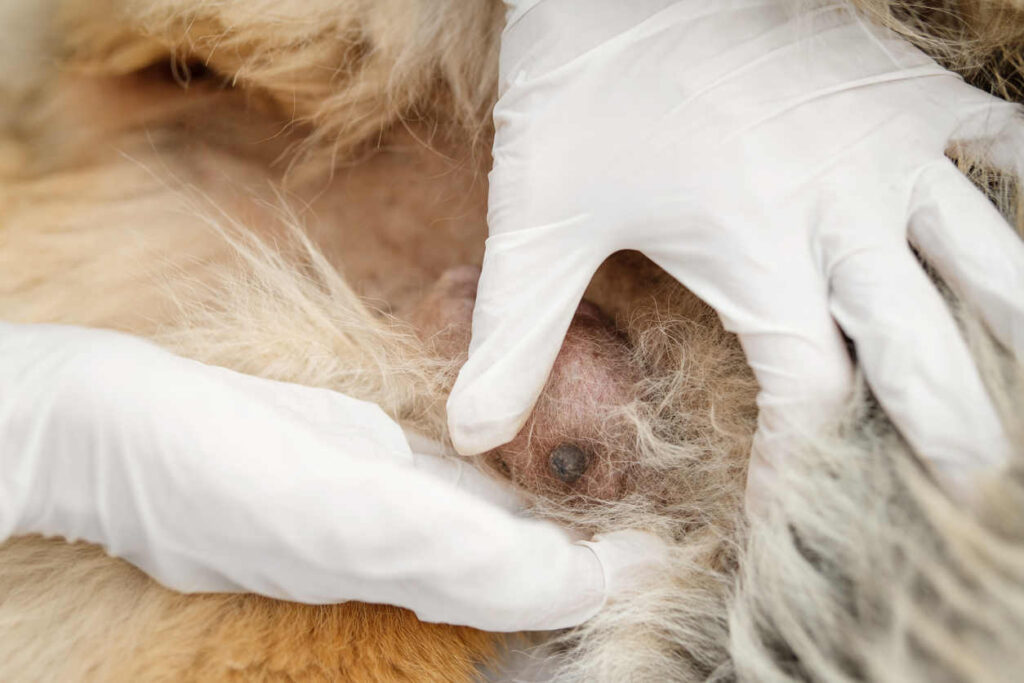
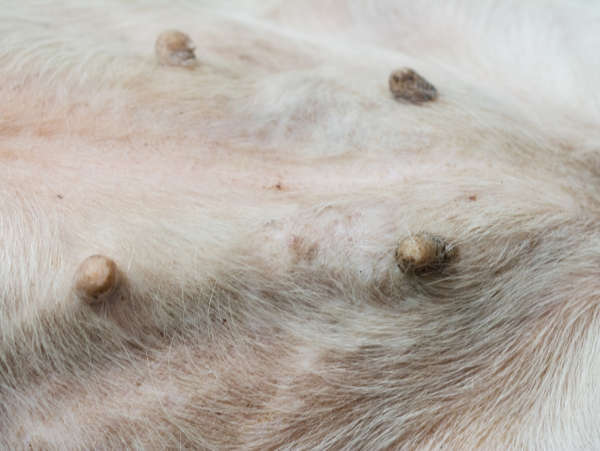
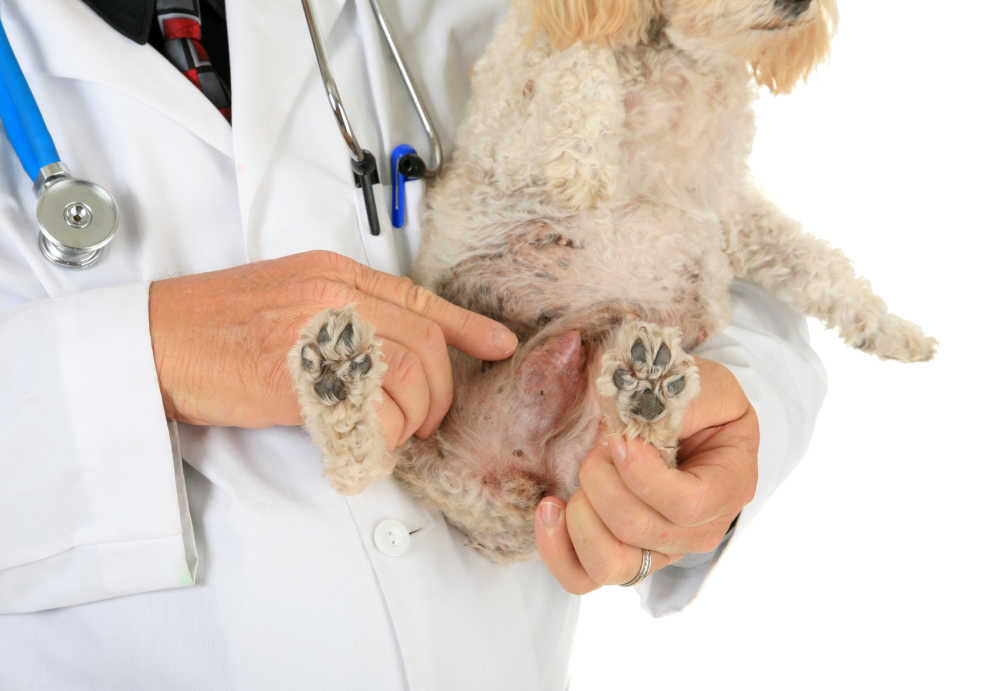
Mammary gland tumors can be cancerous or benign. They are often located next to or beneath the nipple and may extend between multiple mammary glands. They are firm and may have ulcerated skin overlaying or be abscessed/bleeding. Due to the lymphatic drainage that links mammary glands together, these tumors can spread quickly to the other mammary glands and even to the rest of the body. Therefore, quick surgical removal is recommended. Spaying a female dog significantly reduces their risk of developing mammary gland tumors.
View more Pictures of Mammary Gland Tumors, with veterinarian advice.
10. Anal sac tumors
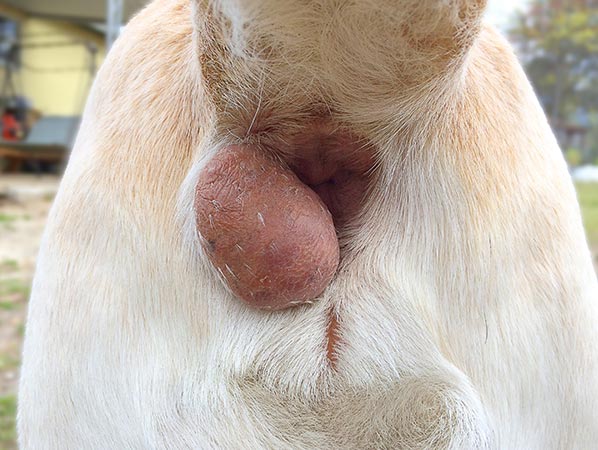
Anal sac tumors (adenocarcinoma) are growths on a dog’s anal glands. They show up as lumps next to the dog’s anus. They are firm and can be ulcerated or infected. Dogs may have difficulty defecating due to the size and pressure on the rectum and anus. Anal gland tumors are nearly always cancerous, grow quickly, and can spread. Anal gland tumors can be surgically removed, but radiation or chemotherapy may be required to remove leftover cells.
Learn more about lumps and bumps in dogs.
Other common skin problems
Hair loss
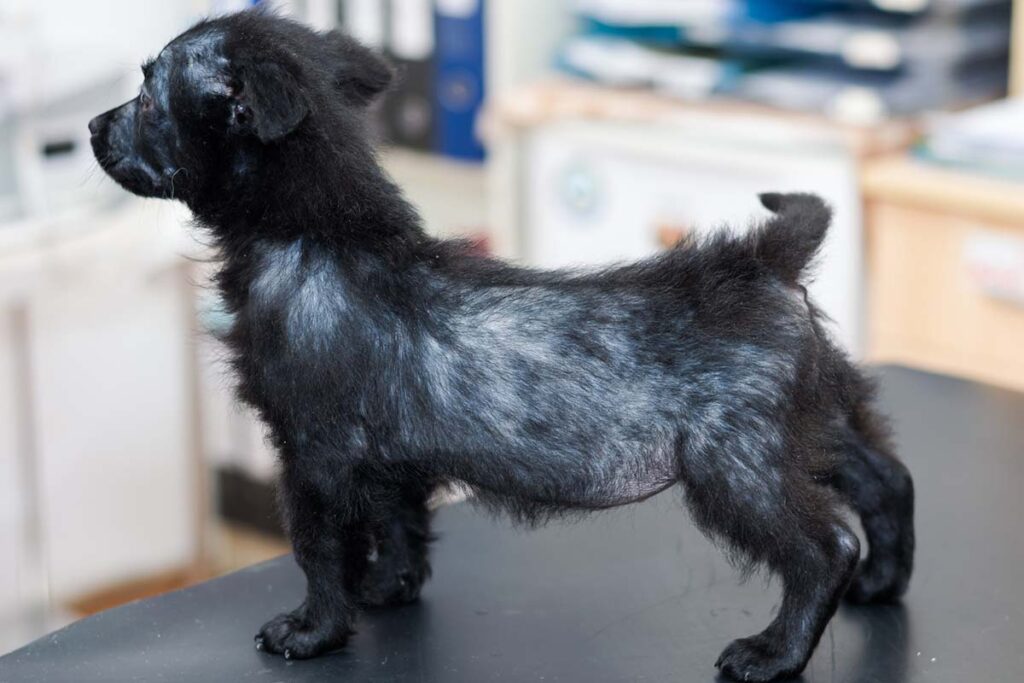
While a dog’s coat may naturally thin at certain times of the year, complete areas of baldness are not normal and can indicate an underlying health condition. There are many causes of hair loss (alopecia) including stress, hormonal disease, self-trauma, external parasites, and poor nutrition. If your dog’s hair isn’t growing back, then you should have them seen by your veterinarian.
Read our articles about Hair Loss.
Black spots
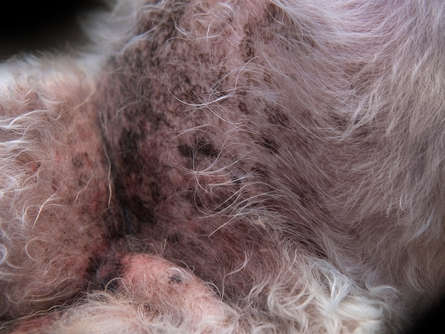
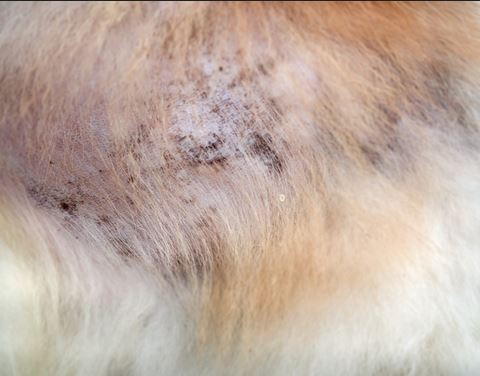
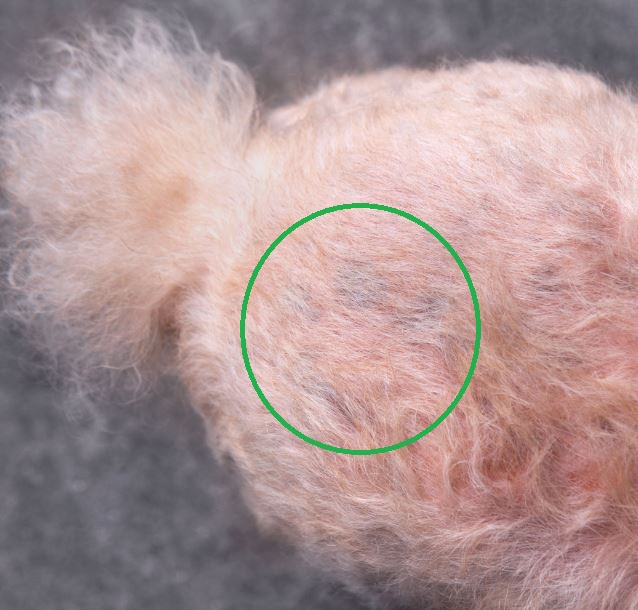
Most instances of dark or black colored spots on the skin of dogs are hyperpigmentation. Hyperpigmentation occurs when there is an increase in dark pigmentation of the skin. Most commonly, the dark or black spots, along with the other signs of redness, scaling, crusting, and itchiness, are secondary to trauma or chronic irritation. Allergies, parasites, injuries, and other things may all cause skin irritation and itching, leading to hyperpigmentation.
Learn more about Black Spots or Brown Spots.
Skin Problems and Conditions by Category:
- Lumps and bumps (including red bumps and black bumps)
- Tumors, Warts, or Cysts (6 Types of cysts in dogs)
- Scabs and blood blisters
- Skin lesions and skin infections
- Cancerous lesions or lumps
- Skin allergy rashes, heat rashes, hot spots
- All skin problems and conditions
Disclaimer: This website's content is not a substitute for veterinary care. Always consult with your veterinarian for healthcare decisions. Read More.


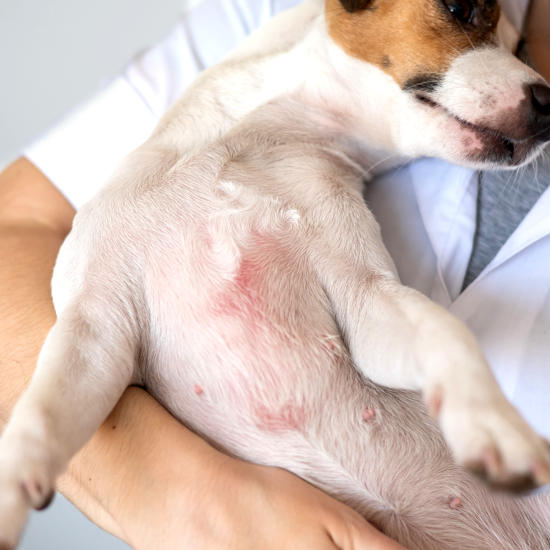
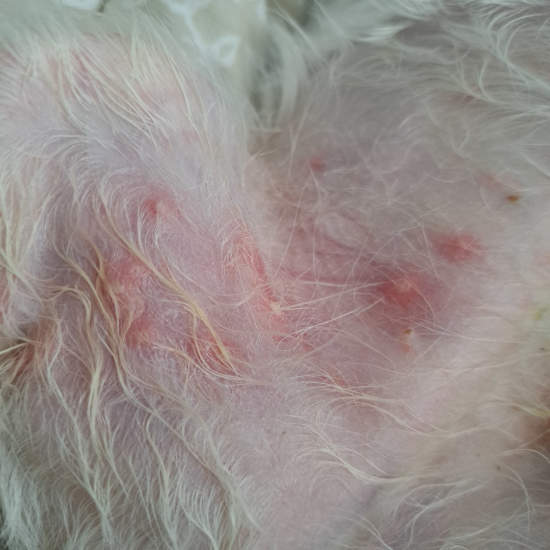
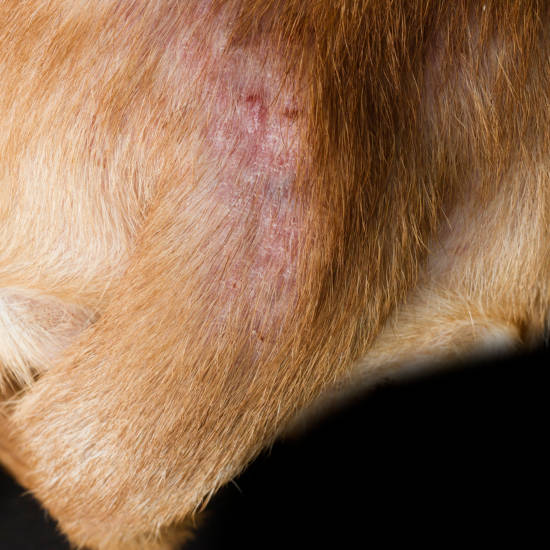
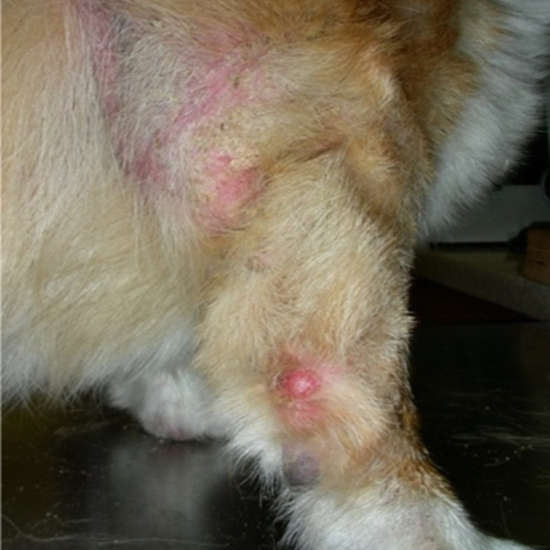


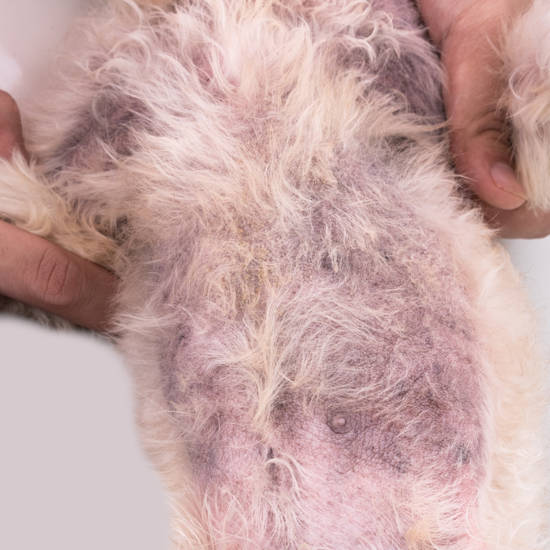


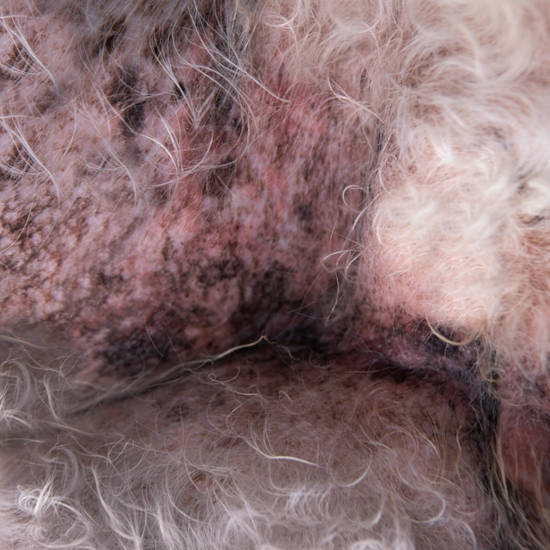
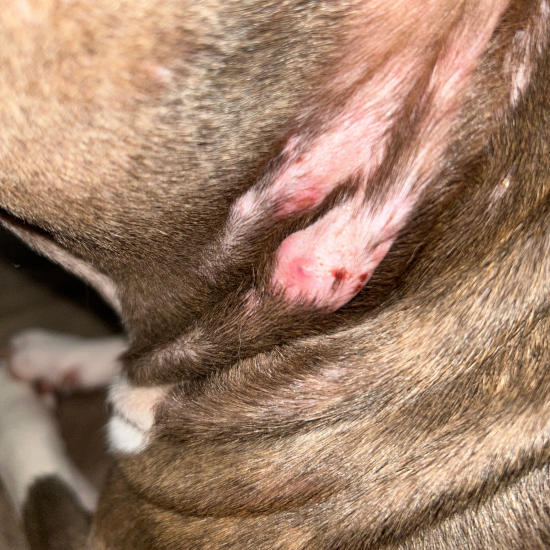












It’s great that you mentioned how the bumps and rashes that you may see on dogs vary, and their appearance could often give clues to their cause. I noticed some strange patches on our pet dog’s skin and I think it is not something simple. We need to have it checked, so I’ll bring our pet dog to a veterinary hospital this Friday.